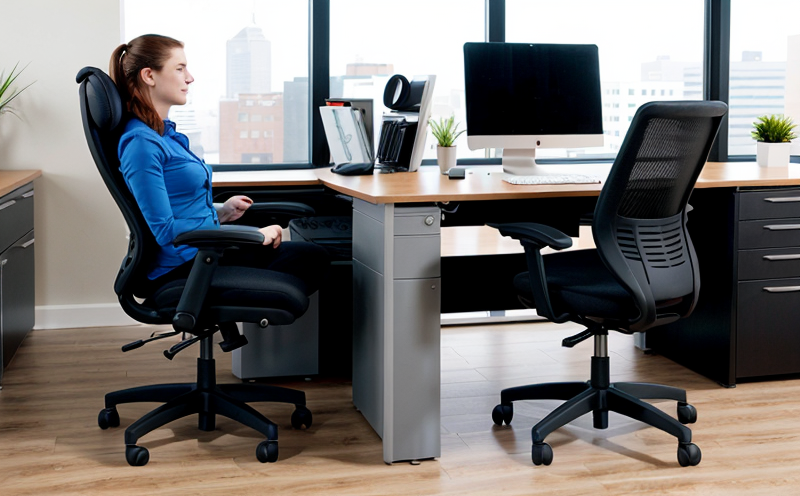BS EN 5459 Office Work Chairs Performance Requirements and Testing
The British Standard/EN standard BS EN 5459 provides comprehensive requirements and testing procedures specifically designed to ensure that office work chairs meet the highest standards of ergonomics, comfort, durability, and safety. This service is essential for manufacturers, quality managers, compliance officers, and R&D engineers who aim to produce high-quality furniture that meets both industry expectations and legal regulations.
Office work chairs are critical components in modern workplaces, impacting employee productivity, health, and overall well-being. The standard covers a range of performance parameters including load-bearing capacity, adjustability, stability, comfort, and the ability to withstand wear and tear over extended periods. Compliance with this standard is not only a requirement for manufacturers but also helps in building trust among customers and regulatory bodies.
The testing process under BS EN 5459 involves several stages designed to evaluate various aspects of office work chairs. These include static load tests, dynamic stability assessments, durability evaluations, and comfort checks. Each test is conducted using specialized equipment that simulates real-world usage conditions as closely as possible, ensuring accurate and reliable results.
Manufacturers often find it beneficial to consult with a reputable laboratory when implementing this standard. Our team of experts can guide you through the process from initial design reviews to final certification, offering valuable insights into meeting all requirements effectively. By partnering with us early in your development cycle, you ensure that every aspect of your product aligns perfectly with BS EN 5459.
Compliance with this standard also offers numerous advantages beyond mere regulatory adherence. It enhances brand reputation by demonstrating a commitment to quality and safety. Additionally, it can lead to increased sales as satisfied customers often recommend products they trust. For R&D engineers working on new designs or improvements, understanding the specific needs outlined in BS EN 5459 provides clear direction for innovation.
Our comprehensive testing services go beyond just meeting minimum standards; we aim to exceed expectations by incorporating advanced techniques and technologies where applicable. This ensures that each chair not only meets but surpasses industry benchmarks, making them suitable even for the most discerning users.
In conclusion, investing in BS EN 5459 compliance through our testing services represents an excellent opportunity to elevate your product offerings significantly. By adhering strictly to these rigorous standards, you demonstrate a commitment to excellence that resonates positively with all stakeholders involved - from suppliers and manufacturers to end-users and regulatory authorities.
Applied Standards
| Standard Code | Description |
|---|---|
| BS EN 5459 | Office work chairs - Performance requirements and testing. |
The primary standard applied here is BS EN 5459, which sets out detailed guidelines for the performance characteristics of office work chairs. This includes aspects such as load capacity, stability under various conditions, adjustability features, comfort levels, and resistance to wear and tear.
Scope and Methodology
| Methodology Component | Description |
|---|---|
| Static Load Tests | Measure the maximum weight a chair can support without compromising stability or comfort. |
| Dynamic Stability Assessments | Evaluate how well the chair maintains its position and posture during movements typical of daily use. |
| Durability Evaluations | Test the longevity of materials used in construction against repeated stressors like sitting, standing, and adjustments. |
| Comfort Checks | Evaluate the ergonomic design elements that contribute to user comfort over extended periods of use. |
The methodology employed encompasses multiple stages designed to comprehensively assess the performance characteristics stipulated by BS EN 5459. Static load tests are conducted first, followed by dynamic stability assessments which involve simulating real-world movements and postures. Durability evaluations follow next, focusing on material resilience against continuous use over time. Finally, comfort checks ensure that ergonomic design elements provide sustained comfort for users.
Why Choose This Test
- Ensures compliance with international standards recognized globally.
- Demonstrates a commitment to quality and safety which enhances brand reputation.
- Promotes trust among customers and regulatory bodies.
- Provides valuable data for continuous improvement in product design.
- Simplifies the certification process by covering all necessary requirements upfront.
Selecting this testing service offers several compelling reasons. Primarily, it ensures full compliance with internationally recognized standards like BS EN 5459, thereby opening up markets to international clients. It also helps establish a reputation for quality and safety that builds customer confidence and trust. Moreover, having all required tests performed upfront simplifies the certification process, making it easier to meet regulatory requirements promptly.
Additionally, these comprehensive evaluations provide valuable insights into areas where improvements can be made within existing designs or in future iterations of products. This information is crucial for ongoing product development efforts aimed at staying ahead of competitors and meeting evolving market demands.





